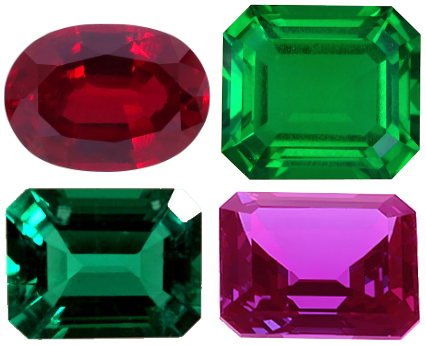Lab Created

Lab Created
Lab Created Gemstones
Gems made in labs can contain a mix of citrine and amethyst crystals, glass with coloring or refraction elements with many other variants. Most lab-created gemstones are usually a copy of existing crystals with very few exceptions.
Lab-made gems are usually cheaper, easier to produce, and can be available in different colors. In some cases, lab-created gemstones might have superior features compared to their natural variants.
Let’s check out vital info about lab-created gemstones, their origins, how to make them, and much more.
History of Lab Created Gemstones
Marc Gaudin is on record as the first chemist to create synthetic gemstones. The French chemist achieved this feat in 1837, even if the gemstones lost transparency after cooling.
It will take another four decades for any meaningful advance in the synthesis of gemstones. Edmond Frémy discovered the now-popular flame fusion method to create solid gemstones from a mix of lead oxide in porcelain vats.
Further advances by Auguste Verneuil (1891), J. Czochralski (1918), and many other scientists gave rise to multiple effective methods to synthesize gemstones.
Many of these methods became commercial quickly and received approval to produce millions of gemstones annually.
Top Methods to Create Lab-Made Gemstones
Crystal pulling
J. Czochralski’s crystal pulling method became popular in the 1910s as an effective method to create durable gemstones. The method involves these steps:
- Radio waves melt aluminum oxide (Al2O3) in a special container,
- Dip a rod with a yellow sapphire crystal element at its tip into the aluminum oxide mixture,
- Slowly rotate and pull out the rod with its gemmed tip to form a ‘pulled’ column of sapphire
Floating zone growing
The floating zone method is another popular procedure to create lab-made gems through this process:
- A sintered rod of powder elements for the gem culture receives intense heating with infrared in a vacuum,
- The rod is rotated to remove impurities and air while crystals form
Hydrothermal growing
The hydrothermal process requires an intense amount of heat and pressure to form crystals from elements. A set of compatible, stable elements placed under high heat causes a reaction, forming crystals with different features.
CVD
Chemical vapor deposition (CVD) is an effective method used to grow hard crystals. The process supports crystalline growth in a chamber where carbon atoms can precipitate to form seed plates.
Verneuil Process or flame fusion
The method is a commercial success and works in creating high-quality rubies. The over 100-year-old process requires dropping powdered elements through high-temperature flames to melt.
A rotating pedestal underneath the hot flame receives the now-mixed and formed synthetic crystal. Many low cost, high efficiency processes rely on flame fusion to create different types of gems. Some of the common gems created through flame fusion are spinel, rubies, and corundum.
Maintenance Tips for Lab-Created Gemstones
Lab-created gems is useful for adornments in jewelry and not for much else. However, the surface of these gemstones might become dull over time without proper maintenance.
You can maintain lab-created gems with:
- Jewelry solvents,
- Polishing cloth,
- Liquid soap solution,
- Steam cleaner
You’ll need to consult your jeweler for more information about top ways to maintain your lab-made gemstones. Some of these gems might possess elements that won’t react well to ammonia in solvents or other cleaners.




